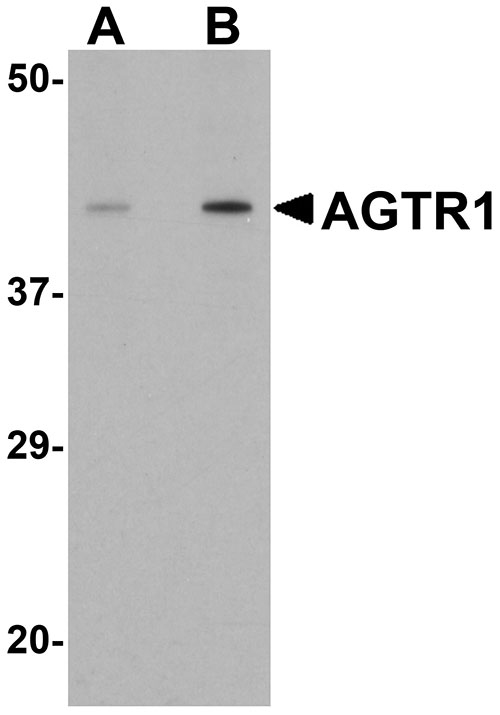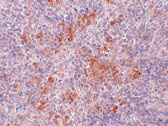AGTR1 Antibody
- 产品详情
- 实验流程
- 背景知识
Application
| WB, IF, E, IHC-P |
|---|---|
| Primary Accession | P30556 |
| Other Accession | EAW78909, 119599315 |
| Reactivity | Human, Mouse, Rat |
| Host | Rabbit |
| Clonality | Polyclonal |
| Isotype | IgG |
| Calculated MW | 41061 Da |
| Concentration (mg/ml) | 1 mg/mL |
| Conjugate | Unconjugated |
| Application Notes | AGTR1 antibody can be used for detection of AGTR1 by Western blot at 1 - 2 µg/mL. Antibody can also be used for immunohistochemistry starting at 2.5 µg/mL. For immunofluorescence start at 20 µg/mL. |
| Gene ID | 185 |
|---|---|
| Other Names | Type-1 angiotensin II receptor, AT1AR, AT1BR, Angiotensin II type-1 receptor, AT1, AGTR1, AGTR1A, AGTR1B, AT2R1, AT2R1B |
| Target/Specificity | AGTR1; |
| Reconstitution & Storage | AGTR1 antibody can be stored at 4℃ for three months and -20℃, stable for up to one year. As with all antibodies care should be taken to avoid repeated freeze thaw cycles. Antibodies should not be exposed to prolonged high temperatures. |
| Precautions | AGTR1 Antibody is for research use only and not for use in diagnostic or therapeutic procedures. |
| Name | AGTR1 (HGNC:336) |
|---|---|
| Function | Receptor for angiotensin II, a vasoconstricting peptide, which acts as a key regulator of blood pressure and sodium retention by the kidney (PubMed:15611106, PubMed:1567413, PubMed:25913193, PubMed:26420482, PubMed:30639100, PubMed:32079768, PubMed:8987975). The activated receptor in turn couples to G-alpha proteins G(q) (GNAQ, GNA11, GNA14 or GNA15) and thus activates phospholipase C and increases the cytosolic Ca(2+) concentrations, which in turn triggers cellular responses such as stimulation of protein kinase C (PubMed:15611106). |
| Cellular Location | Cell membrane; Multi-pass membrane protein |
| Tissue Location | Liver, lung, adrenal and adrenocortical adenomas. |
For Research Use Only. Not For Use In Diagnostic Procedures.
Provided below are standard protocols that you may find useful for product applications.
BACKGROUND
AGTR1 Antibody: Angiotensin II is a potent vasopressor hormone and a primary regulator of aldosterone secretion that acts through at least two types of receptors, AGTR1 and AGTR2. It is an important effector controlling blood pressure and volume in the cardiovascular system and plays a major role in the development of the mammalian kidney and urinary tract. AGTR1, the type 1 receptor, is thought to mediate the major cardiovascular effects of angiotensin II and may play a role in the generation of reperfusion arrhythmias following restoration of blood flow to ischemic or infarcted myocardium. AGTR1 has recently been found to regulate the differentiation of bone marrow-derived monocyte lineage progenitors from hematopoietic stem cells, indicating the diversity of the roles of AGTR1.
REFERENCES
Mottl AK, Shoham DA, and North KE. Angiotensin II type 1 receptor polymorphisms and susceptibility to hypertension: A HuGE review. Gen. in Med.2008; 10:560-574.
Miyazaki Y and Ichikawa I. Role of the angiotensin receptor in the development of the mammalian kidney and urinary tract. Comp. Biochem. Physiol. A Mol. Integr. Physiol.2001; 128:89-97.
Tsubakimoto Y, Yamada H, Yokoi H, et al. Bone marrow angiotensin AT1 receptor regulates differentiation of monocyte lineage progenitors from hematopoietic stem cells. Arterioscler. Thromb. Vasc. Biol.2009; 29:1529-36.
终于等到您。ABCEPTA(百远生物)抗体产品。
点击下方“我要评价 ”按钮提交您的反馈信息,您的反馈和评价是我们最宝贵的财富之一,
我们将在1-3个工作日内处理您的反馈信息。
如有疑问,联系:0512-88856768 tech-china@abcepta.com.























 癌症的基本特征包括细胞增殖、血管生成、迁移、凋亡逃避机制和细胞永生等。找到癌症发生过程中这些通路的关键标记物和对应的抗体用于检测至关重要。
癌症的基本特征包括细胞增殖、血管生成、迁移、凋亡逃避机制和细胞永生等。找到癌症发生过程中这些通路的关键标记物和对应的抗体用于检测至关重要。 为您推荐一个泛素化位点预测神器——泛素化分析工具,可以为您的蛋白的泛素化位点作出预测和评分。
为您推荐一个泛素化位点预测神器——泛素化分析工具,可以为您的蛋白的泛素化位点作出预测和评分。 细胞自噬受体图形绘图工具为你的蛋白的细胞受体结合位点作出预测和评分,识别结合到自噬通路中的蛋白是非常重要的,便于让我们理解自噬在正常生理、病理过程中的作用,如发育、细胞分化、神经退化性疾病、压力条件下、感染和癌症。
细胞自噬受体图形绘图工具为你的蛋白的细胞受体结合位点作出预测和评分,识别结合到自噬通路中的蛋白是非常重要的,便于让我们理解自噬在正常生理、病理过程中的作用,如发育、细胞分化、神经退化性疾病、压力条件下、感染和癌症。








